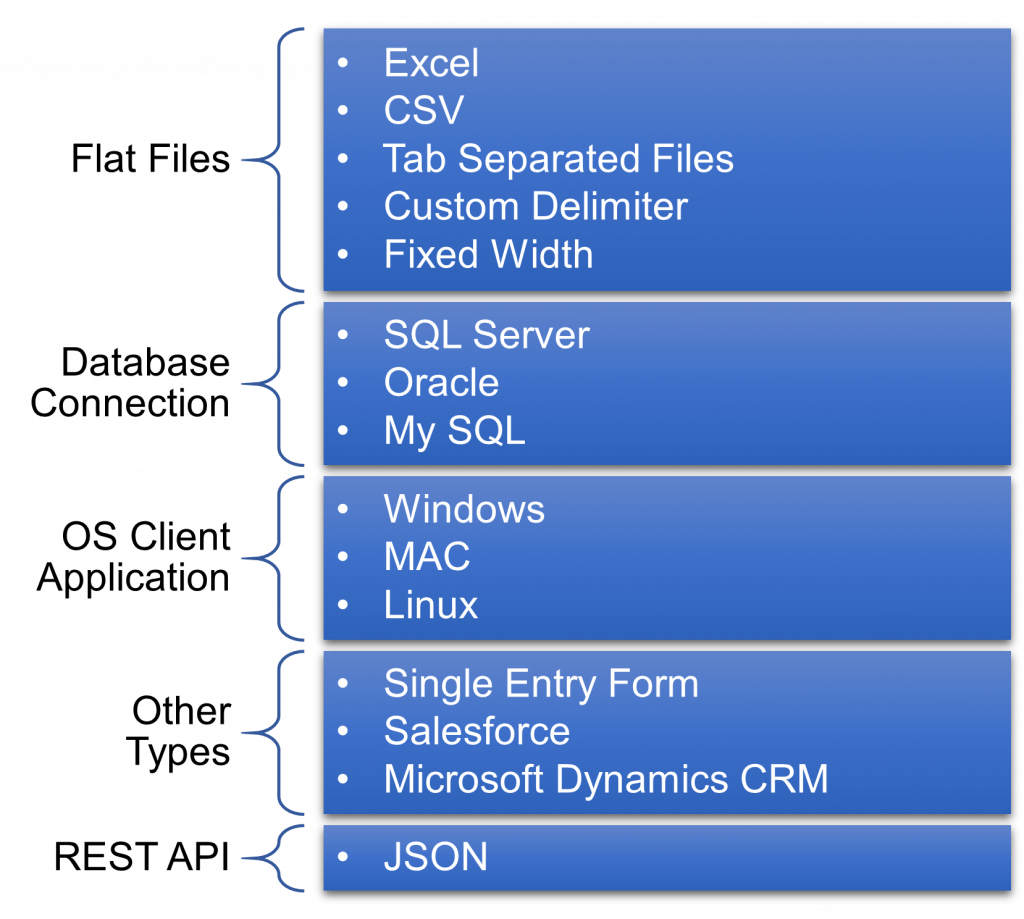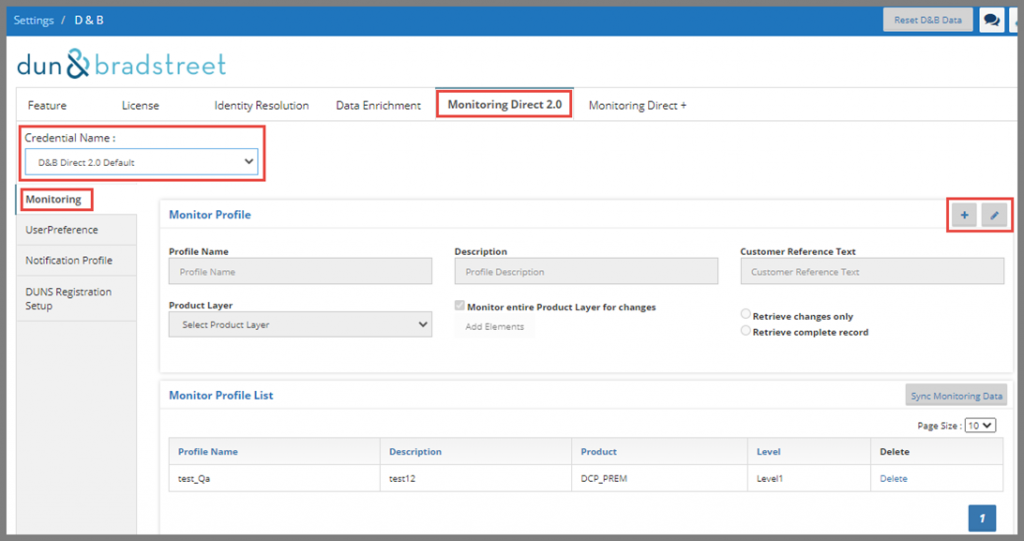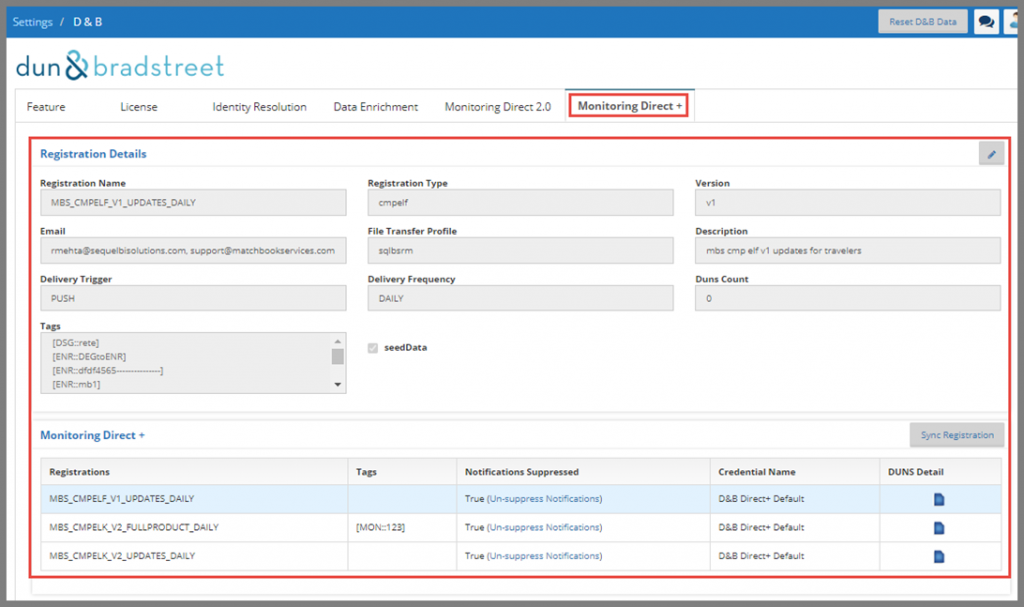Overview #
Matchbook Services is a SaaS solution that acts as a comprehensive business rule layer sitting between your organization and the entire Dun & Bradstreet (D&B) data repository. Matchbook Services provides you with accurate and complete control over your D&B data matching, enrichment, and monitoring processes.
NOTE: The Matchbook Portal should only be used with the following browsers: Chrome, Firefox, and Microsoft Edge.
The diagram below provides a high-level overview of Matchbook Services. Using Matchbook Services, you can load your customer data directly into the solution, manage the entire workflow in the cloud, and improve the quality and accuracy of your organization’s data. Matchbook Services allows you to access any of the Dun & Bradstreet services including Direct 2.0, and Direct+ systems, and provide you the data in a standard and consistent format. Matchbook Services also allows you to fetch data using Cleanse & Match, Data Enrichment, Monitoring, Build A List, and Investigation services.

Typical Process Flow #
The below diagram shows the typical process flow of Matchbook Services:

Process Flow Details #
- Customer Records – Client determines what records to process through Matchbook Services.
- Data Import process – Data can be imported in a multitude of ways and formats.
- Cleanse Match process – Data goes through a cleanse/match process using the selected and granted D&B Direct APIs. The resultant data is processed and categorized into multiple buckets
- Matched Records (reside in the Output queue) – Composed of records that have a singular match candidate for a given input record.
- Low Confidence Matched Records – Composed of records that have multiple match candidates returned for a given input record. These records will require data stewardship intervention for resolution.
- No Matched Records – Composed of records with no match candidates returned. These records will also require data stewardship intervention for resolution.
- Manual Data Stewardship – Data Stewards begin to look at the Low Confidence Match queue to manually match records to the appropriate DUNS Number. Once data stewards manually match a record, that record is sent to the Output queue for export. If the data stewards do not find an appropriate match in the list of match candidates, they can choose to Reject All Matches for that input. This will move the input record into the No Match queue where further investigation can be done to aid in the effort of finding a match candidate.
- Data Enrichment (Optional) – Once a DUNS Number is accepted by the process or a data steward, another API call is made in which appended data is then associated with that DUNS Number. This data can also be exported out of Matchbook Services for consumption by the client.
- Monitoring (Optional) – For customers that subscribe to monitoring services through D&B, Matchbook Services provides the ability to monitor identified records. When changes are detected, those changes are captured by Matchbook Services and can be exported out of the tool for use by the client.
- Download the Match/Enriched/Monitoring Data – Customers can download matched data where they can then integrate back into the organization’s various source systems and appropriate business units.
Key Concepts #
Matchbook Services provides a single overarching solution to integrate and master all your customer data using D&B services. Matchbook Services connects your information to D&B’s expansive database and manages your data in real-time. The key concepts of Matchbook Services include the following:

1. D&B Core Concepts & Definitions #
It is important to understand the following concepts as they are key elements that will help the user better match their data.
DUNS Number #
DUNS (or D-U-N-S) stands for Data Universal Numbering System and is a unique 9-digit identifier for businesses — it is used to maintain information on 330M+ global businesses. Learn more about DUNS numbers here.
Match Grades #
Match Grades are 7 or 11-digit codes used to measure how alike or different the match elements (company name, address, city, etc.) are compared to the company data. There are four values that can be assigned to each component in a Match Grade:
A: content is the same
B: content is similar
F: content is different
Z: content is missing
More information about Match Grade can be found here.
MDP Code #
MDP stands for Match Data Profile. MDP codes are a series of seven, 2-digit codes used to define the source of the matched record within the D&B Match Reference File. The MDP provides specific detail for each of the first seven positions of the Match Grade and describes the type of D&B Reference Database record to which the input record matched. By interpreting the codes, users can learn how the records were matched: Current/Primary, Former, Additional, or Not Available. Knowing this information helps in reviewing the matches and cleaning them if needed. Learn more about MDP codes and what each of those 2-digit codes stands for here.
Confidence Code #
Confidence codes are used to help users evaluate the match results, and to create auto-acceptance rules. Highest/best matches are categorized as 10 and non-matches are categorized as 00.
Sequence Numbers #
Sequence numbers help users sort the matches for each of the input codes based on the likelihood of them being a match. A lower sequence number means the highest/best potential match (i.e. Sequence number = 1 indicates the best match).
2. Data Import #
Matchbook Services “Data Import Process” allows you to import data using the below options. Any user with Admin rights will be able to import data into Matchbook Services and the Data Import validation process will always assist the Admin while entering any invalid data or connections.
Data Import Types: #

3. Tags #
Using the concept of Matchbook Services “Tags”, records can be segmented into multiple groups, and group-specific rules are defined for processing each group’s data. The number of groups is not limited, and any granular level grouping is allowed. Additionally, complete security and consistency are provided so that only users from the respective groups can view the processed records.
For example, imagine a scenario where an organization has 3 million records to be processed by three separate groups (LOBs). Additionally, the data must be divided into four distinct groups where unique rules and filters can be applied to create customized results and data sets visible only to those users from the respective groups. This can be configured within the Matchbook platform as follows:

Tag Types: #
In the Matchbook portal, tags can be categorized into the following:
- Data Processing Tags – Used to define segment and process rules
- Source Tags
- Monitoring Tags
- Data Enrichment Tags
- Security Tags – Used to define security and consistency
- Data Stewardship Tags
- LOB Tags
- Security Tags
4. Configuration and Processing Rules #
Matchbook allows you to pre-define different rules before loading and processing your data. Two separate primary rules must be configured before processing your data:
- Portal Settings – Allow you to segment your data
- D&B Settings – Allow you to apply processing logic using those segments
Under D&B Settings, it is very important to apply the “Cleanse and Match” rules to identify the highly qualified and matching records based on your input record data. Once you set up these matching rules, the records will be processed and executed in an orderly fashion, as highlighted below:
- Minimum Match Criteria – These settings allow you to:
- Define minimum confidence code to be considered for getting the match candidates as part of the D&B Match process
- Define maximum candidates to be considered for each match response
- Exclusions for Cleanse Match API – These settings allow you to define your filter match candidate exclusions:
- Exclude Non-Headquarters
- Exclude Non-Marketable
- Exclude Out of Business
- Exclude Undeliverable
- Exclude Unreachable
- Auto-Acceptance – These rules are also referred to as secondary auto-acceptance rules. They allow you to define and accept match records with a combination of Match Criteria, Confidence Code value, Match Grade component value, Match Grade pattern, and MDP value.
- Auto-Accept Directives – These settings allow you to define rules to fine-tune the candidate selections that can be auto-accepted by the system.
Once qualified and matching businesses are identified for given inputs using identity resolution service responses, enrichment and monitoring processes will be performed based on other settings.
5. Enterprise Security #
Matchbook Services allows you to handle all your data with complete security and consistency using the below user security roles and tags mechanism(s). You will be able to control user access to specific groups or tags under a single line of business or multiple lines of business.
User Roles: #
- Enterprise Administrator – This role will have permissions to manage all users, tags, data in the complete enterprise system.
- Line of Business Administrator – This role can manage all users and data for a specified Line of Business.
- Data Steward – This role can be sub-classified into two roles:
- Enterprise Data Steward – Can access one or multiple LOB data based on the source tags assignment
- Line of Business Data Steward – Can access records from a specified data steward
Typical Enterprise Security Model: #

With the above classified roles/users:
- Any complex enterprise data with multiple LOBs and groups can be easily managed and maintained with integrity and consistency.
- Security and access features can be added using tags for managing the data between multiple Lines of Business and data will not be shared with other LOB.
- Data Stewards can be restricted to a single or multiple tags from a single or multiple LOBs.
- LOB Administrator can manage all users, line of business rules, and data division for a specified LOB.
- Enterprise Administrators will have complete access to your Matchbook enterprise system.
6. Integration with Dun & Bradstreet Services #
Depending on your organization’s contract with Dun & Bradstreet for accessing its services, Matchbook Services can integrate its services behind the scenes with multiple Dun & Bradstreet Services including D&B Direct+, and D&B Direct 2.0 systems. You will be provided the flexibility to configure combinations of different services using these Dun & Bradstreet Services. For example, you could configure Cleanse-Match of D&B Direct+ for identifying and matching your customer records, and configure data enrichment using the Direct 2.0 system or vice versa.
Matchbook Services will allow you to consume all portal services noted below in conjunction with Dun & Bradstreet data based on the organization’s subscription model:
- Cleanse & Match Service
- Product Enrichment Service
- Custom Product Enrichment Service
- Monitoring Service
- Investigation Service
- Build A List Service
In addition to the above, Matchbook Services allows you to:
- Configure and access all these services through the Matchbook Portal and its REST API services.
- REST API features will allow you to pull match & append to make any instant decisions on your business needs for a given business.
- Configure separate ids for processing separate services.
7. Data Export #
Matchbook Services “Data Export Process” allows you to export data at any stage during processing. Data can be exported using multiple combinations of the below options. Any user with “Admin” rights will be able to export data from Matchbook Services.
Data Export Types: #

The Monitoring feature allows users to track any changes that were made to the records that they have pulled from the D&B database. This service allows users to make sure that they always have up-to-date data on any given business which they retrieved from the D&B database.
Matchbook Services has created a front-end UI that sits on top of this D&B Service. For more detailed information, please visit this link.
8. Monitoring Direct 2.0 #

- Monitoring Profile: A Monitoring Profile establishes the specific data fields within a given data layer that should be monitored, and the conditions under which a change event should be triggered. There are no fees involved with establishing Monitoring Profiles, and customers may create as many profiles as needed
- User Preference: A User Preference captures the technical details required to deliver information through various protocols, including Email, File Transfer Protocol (FTP) and HTTP Callback
- Notification Profile: A Notification Profile establishes the protocol by which change events should be delivered to customers, and references user preferences setup in the User Service. This is the PUSH component of the Data Field Monitoring feature
- DUNS Registration Setup: The Monitoring Registration combines Monitoring and Notification Profiles with a specific DUNS Number and initiates the Data Field Monitoring process. There are two levels of monitoring: change events only, or events with data layer included.
9. Monitoring Direct+ #
Monitoring Direct+ is a service created by D&B for specific products, based on customer entitlements and requirements. Customers can register/seed DUNS to be monitored in order to receive notifications when changes occur to any registered DUNS.
If only specific records need to be monitored, customers can add Tags for the Monitoring Registration in the Matchbook portal.
Customers can export monitoring updates from the Export UI:





